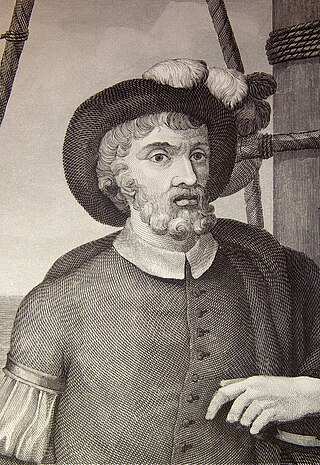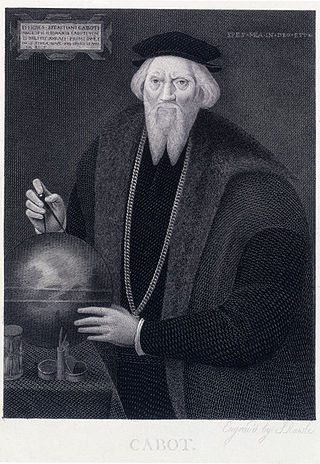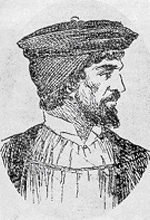External links
- Lanctot, Gustave (1979) [1966]. "Agramonte, Juan de". In Brown, George Williams (ed.). Dictionary of Canadian Biography . Vol. I (1000–1700) (online ed.). University of Toronto Press.
Juan de Agramonte (fl. 1511) (in Catalan, Joan d'Agramunt) was a sailor from Catalonia thought to have possibly travelled to Newfoundland, Canada in 1511.
Because of England's ever increasing voyages to the New World, Spain became concerned by English intrusions into her territories, and planned to explore the north Atlantic coast in order to take possession of it. Juan de Dornelos was placed in command of an expedition in 1500 which never did happen as the expedition was never put to sea.
After the failed attempt in 1500, Agramonte, a sailor and native of Lleida, signed a contract with the daughter of Ferdinand of Aragon on October 29, 1511, to lead an expedition of discovery and exploration to Terra Nova in the years following the voyages of John Cabot. The expedition, which was to comprise two ships, had orders not to land on soil under the jurisdiction of the kingdom of Portugal.
It has been speculated that this expedition also did not take place. The fact that these expeditions were contemplated furthers the notion that the shores of Newfoundland had previously been visited by the Bretons and that a part of the Newfoundland territory had been discovered by Portugal.

Year 1511 (MDXI) was a common year starting on Wednesday of the Julian calendar.

The history of the Kingdom of Portugal from the Illustrious Generation of the early 15th century to the fall of the House of Aviz in the late 16th century has been named the "Portuguese golden age" and the "Portuguese Renaissance". During this period, Portugal was the first European power to begin building a colonial empire as during the Age of Exploration Portuguese sailors and explorers discovered an eastern route to India as well as several Atlantic archipelagos and colonized the African coast and Brazil. They also explored the Indian Ocean and established trading routes throughout most of southern Asia, sending the first direct European maritime trade and diplomatic missions to Ming China and to Japan, at the same time installing trading posts and the most important colony: Portuguese Macau. The Portuguese Renaissance produced a plethora of poets, historians, critics, theologians, and moralists. The Cancioneiro Geral by Garcia de Resende is taken to mark the transition from Old Portuguese to the modern Portuguese language.

Gaspar Corte-Real (1450–1501) was a Portuguese explorer who, alongside his father João Vaz Corte-Real and brother Miguel, participated in various exploratory voyages sponsored by the Portuguese Crown. These voyages are said to have been some of the first to reach Newfoundland and possibly other parts of eastern Canada.

Portuguese colonization of the Americas constituted territories in the Americas belonging to the Kingdom of Portugal. Portugal was the leading country in the European exploration of the world in the 15th century. The Treaty of Tordesillas in 1494 divided the Earth outside Europe into Castilian and Portuguese global territorial hemispheres for exclusive conquest and colonization. Portugal colonized parts of South America, but also made some unsuccessful attempts to colonize North America.

Sir Martin Frobisher was an English sailor and privateer who made three voyages to the New World looking for the North-west Passage. He probably sighted Resolution Island near Labrador in north-eastern Canada, before entering Frobisher Bay and landing on present-day Baffin Island. On his second voyage, Frobisher found what he thought was gold ore and carried 200 tons of it home on three ships, where initial assaying determined it to be worth a profit of £5.20 per ton. Encouraged, Frobisher returned to Canada with an even larger fleet and dug several mines around Frobisher Bay. He carried 1,350 tons of the ore back to England, where, after years of smelting, it was realized that the ore was a worthless rock containing the mineral hornblende. As an English privateer, he plundered riches from French ships. He was later knighted for his service in repelling the Spanish Armada in 1588.

Juan Ponce de León was a Spanish explorer and conquistador known for leading the first official European expedition to Puerto Rico in 1508 and Florida in 1513. He was born in Santervás de Campos, Valladolid, Spain, in 1474. Though little is known about his family, he was of noble birth and served in the Spanish military from a young age. He first came to the Americas as a "gentleman volunteer" with Christopher Columbus's second expedition in 1493.

Juan Sebastián Elcano was a Spanish navigator, ship-owner and explorer of Basque origin from Getaria, part of the Crown of Castile when he was born, best known for having completed the first circumnavigation of the Earth in the Spanish ship Victoria on the Magellan expedition to the Spice Islands. He received recognition for his achievement by Charles I of Spain with a coat of arms bearing a globe and the Latin motto Primus circumdedisti me.

Conquistadors or conquistadores were the explorer-soldiers of the Spanish and Portuguese Empires of the 15th and 16th centuries. During the Age of Discovery, conquistadors sailed beyond Europe to the Americas, Oceania, Africa, and Asia, colonizing and opening trade routes. They brought much of the new world under the dominion of Spain and Portugal.
Ruy López de Villalobos was a Spanish explorer who led a failed attempt to colonize the Philippines in 1544, attempting to assert Spanish control there under the terms of the treaties of Tordesillas and Zaragoza. Unable to feed his men through barter, raiding, or farming and unable to request resupply from Mexico due to poor knowledge of the Pacific's winds and currents, Villalobos abandoned his mission and fled to the Portuguese-held Moluccas, where he died in prison. He is chiefly remembered for some sources crediting him with naming Leyte the "Philippine Island" in honor of the Spanish crown prince Philip. The name was later extended across the entire Philippine Archipelago and its nation.

Sebastian Cabot was a Venetian explorer, likely born in the Venetian Republic and a Venetian citizen. He was the son of Venetian explorer John Cabot and his Venetian wife Mattea.

The Age of Discovery also known as the Age of Exploration, part of the early modern period and largely overlapping with the Age of Sail, was a period from approximately the 15th century to the 17th century, during which seafarers from a number of European countries explored, colonized, and conquered regions across the globe. The Age of Discovery was a transformative period in world history when previously isolated parts of the world became connected to form the world system and laid the groundwork for globalization. The extensive overseas exploration, particularly the European colonization of the Americas, with the Spanish and Portuguese, and later the British, at the forefront, spurred global trade. The interconnected global economy of the 21st century has its roots in the expansion of trade networks during this era.

Juan de la Cosa was a Castilian navigator and cartographer, known for designing the earliest European world map which incorporated the territories of the Americas discovered in the 15th century. De la Cosa was the owner and master of the Santa María, and thus played an important role in the first and second voyage of Christopher Columbus to the West Indies.

João Vaz Corte-Real was a Portuguese sailor, claimed by some accounts to have been an explorer of a land called Terra Nova do Bacalhau, speculated to possibly have been a part of North America. These accounts assert that Corte-Real was awarded the donatário–captaincies of São Jorge and Angra for his accomplishments, but contemporary documents contradict this claim.
Miguel Corte-Real was a Portuguese explorer who charted about 600 miles of the coast of Labrador. In 1502, he disappeared while on an expedition and was believed to be lost at sea.
The history of Saint Pierre and Miquelon is one of early settlement by Europeans taking advantage of the rich fishing grounds near Saint-Pierre and Miquelon, and is characterized by periods of conflict between the French and British.

Portuguese maritime exploration resulted in the numerous territories and maritime routes recorded by the Portuguese as a result of their intensive maritime journeys during the 15th and 16th centuries. Portuguese sailors were at the vanguard of European exploration, chronicling and mapping the coasts of Africa and Asia, then known as the East Indies, and Canada and Brazil, in what came to be known as the Age of Discovery.

John Cabot was an Italian navigator and explorer. His 1497 voyage to the coast of North America under the commission of Henry VII, King of England is the earliest known European exploration of coastal North America since the Norse visits to Vinland in the eleventh century. To mark the celebration of the 500th anniversary of Cabot's expedition, both the Canadian and British governments declared Cape Bonavista, Newfoundland as representing Cabot's first landing site. However, alternative locations have also been proposed.
William Weston, a 15th-century merchant from Bristol, was probably the first Englishman to lead an expedition to North America, the voyage taking place most likely in 1499 or 1500. Evidence of Weston's leadership has been discovered only in the early 21st century, and it changes interpretations of the discovery era.
The exploration of North America by European sailors and geographers was an effort by major European powers to map and explore the continent with the goal of economic, religious and military expansion. The combative and rapid nature of this exploration is the result of a series of countering actions by neighboring European nations to ensure no single country had garnered enough wealth and power from the Americas to militarily tip the scales over on the European continent. It spanned the late 15th to early 17th centuries, and consisted primarily of expeditions funded by Spain, England, France, and Portugal. See also the European colonization of the Americas.

A number of states and polities formerly claimed colonies and territories in Canada prior to the evolution of the current provinces and territories under the federal system. North America prior to colonization was occupied by a variety of indigenous groups consisting of band societies typical of the sparsely populated North, to loose confederacies made up of numerous hunting bands from a variety of ethnic groups, to more structured confederacies of sedentary farming villages, to stratified hereditary structures centred on a fishing economy. The colonization of Canada by Europeans began in the 10th century, when Norsemen explored and, ultimately unsuccessfully, attempted to settle areas of the northeastern fringes of North America. Early permanent European settlements in what is now Canada included the late 16th and 17th century French colonies of Acadia and Canada, the English colonies of Newfoundland (island) and Rupert's Land, the Scottish colonies of Nova Scotia and Port Royal.